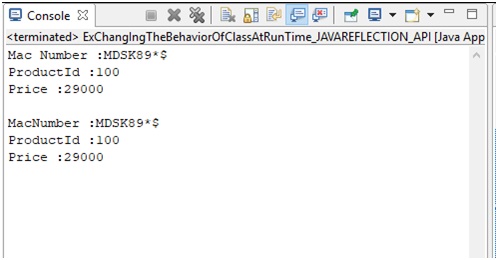
- #JAVA REFLECTION TUTORIAL HOW TO#
- #JAVA REFLECTION TUTORIAL PATCH#
- #JAVA REFLECTION TUTORIAL SOFTWARE#
- #JAVA REFLECTION TUTORIAL CODE#
Methods.addAll(Arrays.asList(clazz.getDeclaredMethods())) Public static Method getAllMethods(final Class clazz) Return findMethod(clazz.getSuperclass(), methodName, parameterTypes) Return clazz.getDeclaredMethod(methodName, parameterTypes) Public static Method findMethod(final Class clazz, final String methodName, final Class. Return findField(clazz.getSuperclass(), fieldName) Return clazz.getDeclaredField(fieldName)

Public static Field findField(final Class clazz, final String fieldName) Public static String modifierToString(final int modifier) * verschiedene Hilfsmethoden zur vereinfachten Handhabung von Reflection * Die Klasse ReflectionUtils ist eine Utility-Klasse, die Java source – The helper class: ReflectionUtils.java package utils Java source: CanConstruct.java package utils Java source: CanChange.java package utils

Java source: ClassInfo.java package utils Construct a new AnnotationRunner instance and printout the int field id1 by using reflection code:ĪnnotationRunner r = (AnnotationRunner)ctor.newInstance() įield f = r.getClass().getDeclaredField("id1") į.setAccessible(true) Note all of the above Anotations are used during Runtime and thus = RetentionPolicy.RUNTIME) is mandatory Indicates that we can/should run a certain JAVA Constructor via reflection Change a int field by using reflection code:į.setInt(runner,k) CanConstruct - = ElementType.CONSTRUCTOR) Indicate that we can/should modify a certain JAVA methode via reflection Method.invoke(runner) CanChange - = ElementType.FIELD) Run that specific methode by using reflection code: Indicate that we can/should run a certain JAVA methode via reflection
#JAVA REFLECTION TUTORIAL CODE#
Use reflection code below to display the Anotation InfoĬlassInfo myAnnotation = (ClassInfo) annotation Provide some Info who has changed a certain specific JAVA source
#JAVA REFLECTION TUTORIAL HOW TO#
Later, the JVM or other programs can look for the metadata to determine how to interact with the program elements or change their behavior
#JAVA REFLECTION TUTORIAL SOFTWARE#


Gabriel Felix on Can’t start Virtualbox VM – Error VERR_VD_IMAGE_READ_ONLY.Mayank Singh on RAC 12c : Pluggable Databases.SUSOVAN GHOSH on Creating Standard Groups, Users for 11.2 GRID installation.
#JAVA REFLECTION TUTORIAL PATCH#


 0 kommentar(er)
0 kommentar(er)
